Influ2 is marketed as the first person-based account-based marketing platform.
It promises to target ads at specific individuals within your target accounts.
That’s a bold twist on the usual account-level tactics.
In theory, it sounds like ABM is finally getting personal.
In practice, is Influ2 delivering substance or just repackaging what savvy marketers already do (uploading contact lists to LinkedIn, anyone)?
This deep dive takes a deeper look at Influ2’s features, pricing, user feedback, and where it stands in the crowded ABM landscape.
We’ll also see how ZenABM (a first-party LinkedIn-focused ABM platform) might be a better alternative or even serve as a complementary layer to Influ2 or whichever ABM suite you have.

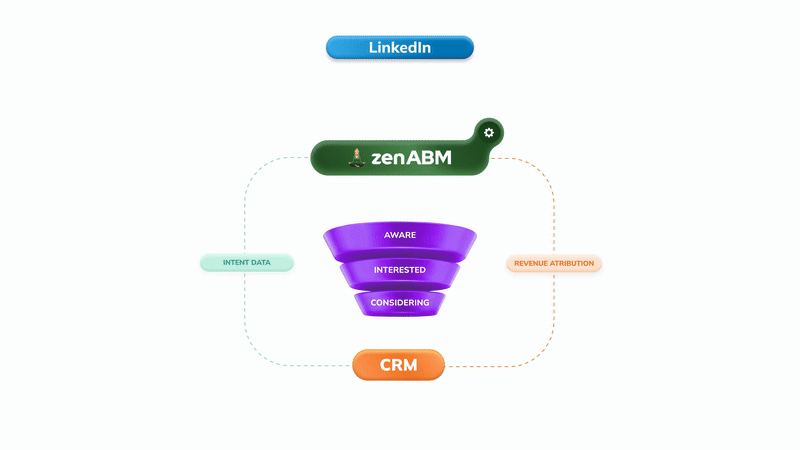
Influ2 for ABM: Quick Summary
In case you want it short:
- Influ2 promises person-based ABM with individual level ad targeting and engagement insights, but its accuracy and reliability vary.
- Pricing is opaque and expensive, with credit based costs that scale sharply as your target list grows.
- Users like the precision and integrations but often complain about reporting gaps, creative limits, and the high cost per contact reached.
- Alternative Worth Considering: ZenABM offers account-level LinkedIn ad engagement tracking, ad engagement-to-pipeline analytics with plug-and-play dashboards, account scoring, ABM stage tracking, CRM sync, first-party qualitative intent, automated assignment of BDRs to hot accounts, custom webhooks, and ad engagement tracking at the job-title level. All this starts at just $59/month!
Key Features of Influ2
Influ2 is about person-based advertising and ABM.
Let’s look at its core offerings:
Multi-Channel Contact-Level Targeting
Unlike many ABM platforms that stick to company-level audiences, Influ2 shows ads to specific individuals on major ad networks.
For example, you could target Jane Doe, CIO of Acme Corp, and have her see your ad on LinkedIn and later on a news site via Google Display.
No more wasting impressions on interns and random folks at the account who aren’t influencers in the deal.
How reliable is that matching?
Well, that is low 🙁
A study by Syft found that IP-matching accuracy for website visitor identification is a mere 42%.

Contact-Level Engagement Tracking
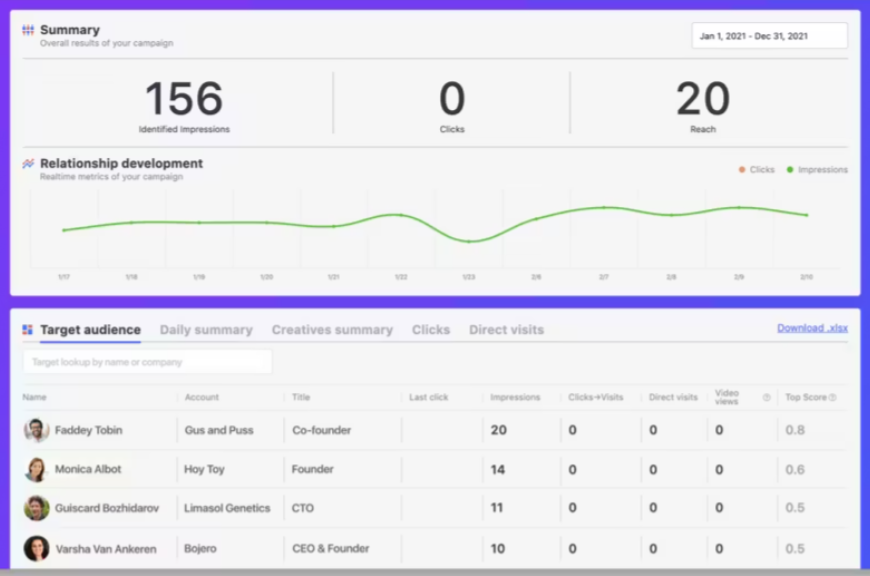
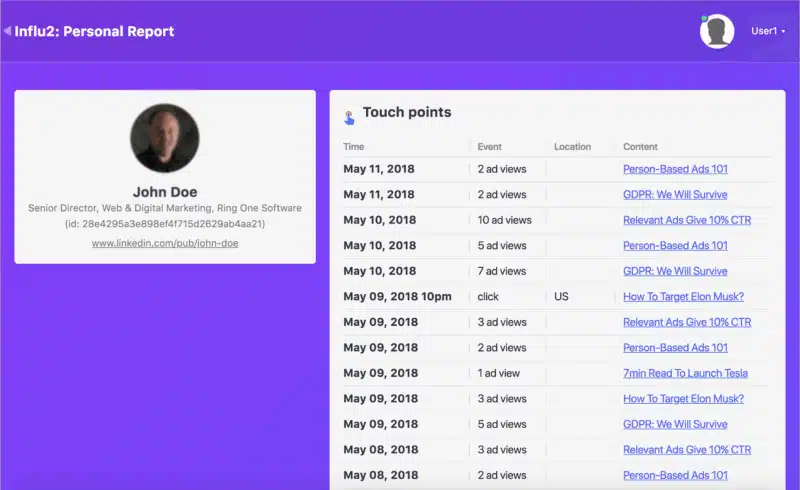
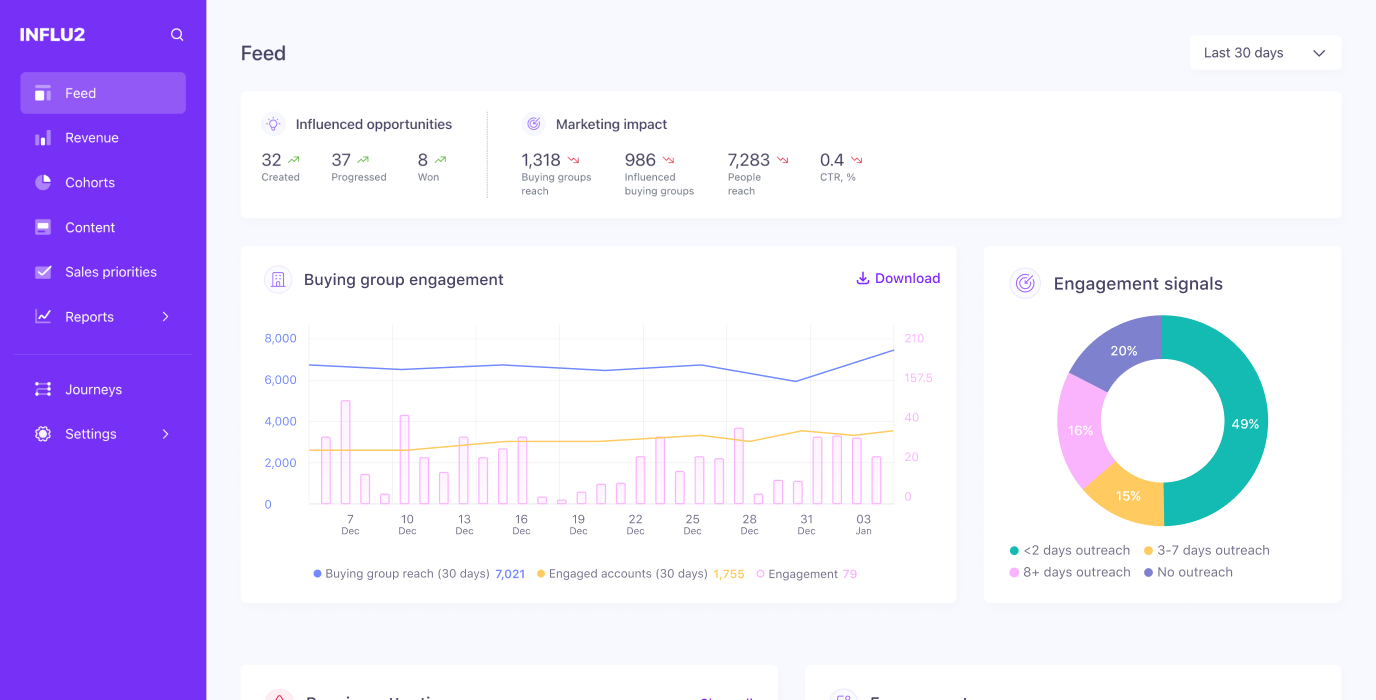
The platform doesn’t just blast ads; it tells you exactly who saw or clicked them.
Influ2 will report impressions, clicks, and even website visits by individual name for each target on your list.
Your sales team can get real-time intel like “John Doe (Senior Director at Dream Account) saw 45 impressions and clicked 3 of them.”
Armed with these contact-level intent signals, sales knows who’s engaging and can tailor outreach accordingly.
Buyer Intent Signals

Influ2 also tracks for third-party intent signals like keyword searches and the sites visited by your target contacts.
Pro Tip: Influ2 can surface third-party intent, like what keywords people may be searching or which sites they might be browsing, but that data is borrowed and often fuzzy. B2B buying decisions come from whole accounts, not a single contact’s browsing history, so these signals rarely map cleanly to real purchase momentum. ZenABM takes a cleaner route by giving you first-party company-level intent straight from your own LinkedIn ads. You see exactly which companies engaged with which feature-focused creative, which campaigns woke them up, and how their interest is shifting in real time.

Automated Journeys & Personalization

Influ2 enables automated ad sequencing based on engagement triggers.
If Jane Doe clicked Ad A, you can automatically move her to see Ad B next, mirroring a personalized buyer’s journey.
The platform lets you set up rules so each contact’s ad experience evolves as they progress (or don’t) through the funnel.
It’s like marketing automation workflows, but for ads aiming to keep each person engaged with content relevant to their stage.
In theory this delivers the right message to the right person at the right time.
In practice, it’s only as good as the logic you set and your content variety.
Some users have noted the platform’s dynamic personalization could be stronger and more flexible, so it may not quite be the choose-your-own-adventure experience the marketing materials imply.
Integration with CRM & Sales Tools
As a modern ABM tool, Influ2 plays nicely with the rest of your tech stack.
It offers integrations with major CRMs and marketing platforms like Salesforce, HubSpot, Marketo, Microsoft Dynamics, and marketing automation systems like Eloqua.
It also connects to sales engagement tools such as Outreach and Salesloft, and even collaboration hubs like Slack and Microsoft Teams.
The idea is to funnel those precious contact-level insights directly to where your sales and marketing teams live – e.g. pinging a Slack channel when a target account contact engages, or updating CRM lead records with ad engagement data.
Users generally praise these integration capabilities, though a few have struggled aligning Influ2 with certain existing workflows.
Implementation typically takes around one month on average, which is relatively speedy for an ABM platform (some competitors require a small army of consultants and several months to get rolling).
Analytics and Revenue Attribution

Influ2 platform provides dashboards to tie ad engagements to pipeline and revenue outcomes.
For example, you can see metrics like “982 buying groups influenced, 234 opportunities generated, 158 progressed, 17 won” – all attributed to people who saw or clicked ads. It offers revenue influence reports to show how ad campaigns contributed to deals.
Data Handling & Privacy
Given the person-specific nature, data privacy is a big consideration.
Influ2 markets a “unique privacy-first technology” where their algorithm matches contacts in a GDPR/CCPA-compliant way.
They are SOC 2 Type II certified for data protection.
Essentially, they use hashed emails and first-party data rather than shady third-party cookies to target individuals.
This is meant to reassure your legal team that uploading a list of contacts is done securely and that ad targeting doesn’t violate ad network policies.
Plus, the tool has built-in ad creative storage too:
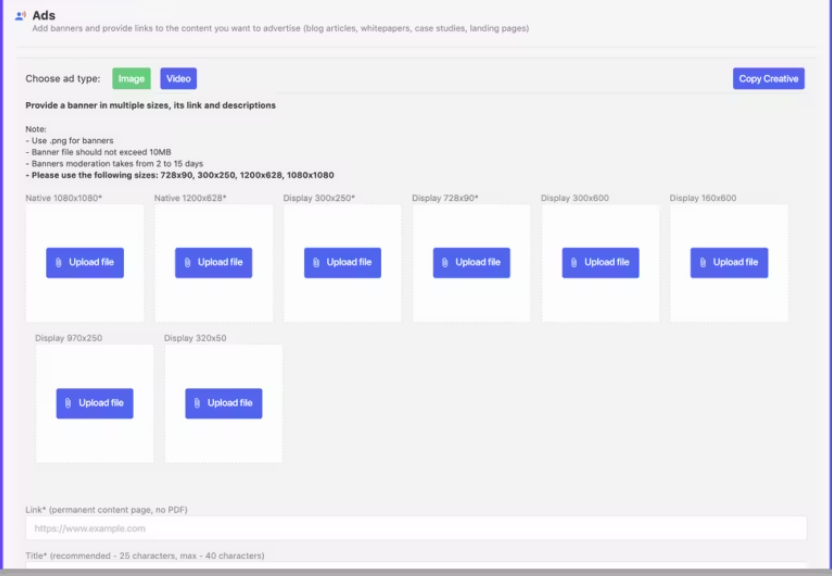
Sales Priorities

Influ 2 provides a list of hot accounts and the specific contacts within them that the sales team must attend to.
Influ2 Pricing: How Much Does It Cost?
If you’re hoping to find clear pricing on Influ2’s website, sorry, you won’t.
Influ2 follows the enterprise software tradition of “Contact us for pricing”, with custom quotes based on your situation.
But here’s what’s available on third-party sources:
- Their model is based on the number of people you target, bundling both the software and media spend into one flat fee. In other words, you pay a set rate to reach X number of contacts, rather than paying per click or impression directly. They pitch this as a simpler way to budget: no variable CPC/CPM surprises, just one price for your list size. Great, except it also means if you want to double your coverage from 5,000 to 10,000 people, expect that price to jump.
- So how expensive is it? G2’s data suggests users perceive Influ2 in the highest cost tier (“$$$$$”). One reviewer complained that “the pricing per reach is too high… Influ2 charges $5 for each contact engaged, called a credit.”
 Let that sink in: $5 per contact who interacts (clicks or even just sees an ad). If you have 1,000 contacts on your target list, you could be looking at ~$5,000 for them to be reached and that’s on top of whatever internal cost to produce ads and manage the program. That user also noted their results were underwhelming for the price: the target contacts didn’t even recall the brand after clicking ads.
Let that sink in: $5 per contact who interacts (clicks or even just sees an ad). If you have 1,000 contacts on your target list, you could be looking at ~$5,000 for them to be reached and that’s on top of whatever internal cost to produce ads and manage the program. That user also noted their results were underwhelming for the price: the target contacts didn’t even recall the brand after clicking ads. - Influ2’s own marketing says “only pay for the people you reach” and emphasizes no platform fees or integration fees. Essentially you’re pre-paying for guaranteed impressions to specific people. If those people are hard to catch online or have strict ad filters, that’s your risk. You’re still paying for the attempt.
- A positive note: G2 users report ROI in ~7 months on average after implementing Influ2.
 That implies that for some, the deals influenced by Influ2 within a few quarters justify the cost. The critical view is that Influ2 probably makes the most sense financially if your deal sizes are large (enterprise B2B deals worth $50k, $100k+ each). Spending, say, $50k a year on Influ2 to help close $1M in new business could pencil out. This isn’t a tool for the scrappy startup with $5k total ad budget; it’s for teams willing to invest serious money to get in front of hard-to-reach decision makers.
That implies that for some, the deals influenced by Influ2 within a few quarters justify the cost. The critical view is that Influ2 probably makes the most sense financially if your deal sizes are large (enterprise B2B deals worth $50k, $100k+ each). Spending, say, $50k a year on Influ2 to help close $1M in new business could pencil out. This isn’t a tool for the scrappy startup with $5k total ad budget; it’s for teams willing to invest serious money to get in front of hard-to-reach decision makers.
User Impressions and Reviews
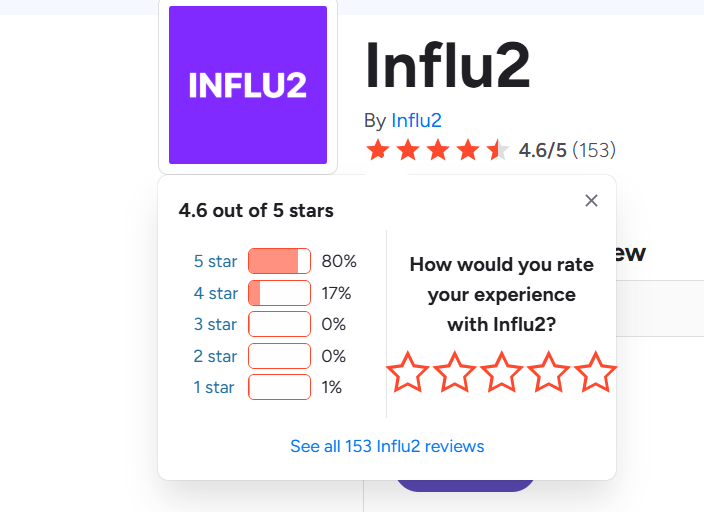
Influ2 enjoys a 4.6/5 average rating on G2 across 150+ reviews, which sounds stellar, but let’s dig into what users actually say.
What users applaud about Influ2:
- Precise Targeting & Insights: Over and over, marketers talk about the ability to zero in on the right people and see exactly what those people do. “I love the highly targeted insights on prospects – I can see which links prospects have clicked and content they viewed,” said one user. Another praised that it’s a “much smarter use of media spend, saving us $1000s a month in waste” by not showing ads to irrelevant audiences. The person-based approach clearly resonates with teams sick of paying for vanity impressions. Influ2 gives tangible data (by name) that can be acted on, which is gold for aligning marketing with sales. As one review summed up: “Influ2 has revolutionized our strategy by allowing us to hone in on exact decision-makers almost every time… the detailed contact-level intent data has empowered our engagement.” That kind of enthusiasm suggests Influ2 is delivering on its targeting promise for many.
- Seamless Integration & Workflow Alignment: Several users mention how easily Influ2 plugged into their existing systems and workflows. “
- Support & Customer Service: Influ2 apparently has exceptional customer support, with users highlighting “knowledgeable assistance and proactive account management.” The support team helps with campaign setup, analysis, and is very responsive despite time zone gaps. This hand-holding is crucial because the concept of person-based ads might be new to many marketing teams.
- Ease of Use (Once Up and Running): Some reviewers describe Influ2’s UI as intuitive and the platform as easy to use.
Where users see pain points or limitations:
- Reporting & Analytics Gaps: Even fans of Influ2 often wish the reporting was more robust. “The platform could benefit from enhanced reporting capabilities – more customizable options to analyze performance and ROI,” one review noted. There are multiple mentions of limited features restricting valuable insights and lack of certain analytics depth. Essentially, the dashboards are good for quick pipeline impact visuals, but if you want to slice-and-dice data or create custom metrics, you might be frustrated. Some found the reporting confusing or lacking visibility into certain performance details.
- Steep Pricing and ROI Concerns: We already touched on pricing. Users definitely feel the burn in their wallet. Beyond cost complaints, a critical theme is value for money. One sales-focused user bluntly said “the pricing per reach is too high” and questioned the engagement quality, noting targets didn’t recall the brand post-click. Some smaller companies likely feel priced out entirely. The credit system ($5 per contact) and annual contracts could also lock you in, so if you don’t see success in a couple of quarters, you’ve still paid for a year.
- Ad Performance and Creative Limitations: A few users pointed out issues around the ads themselves. For instance, one con mentioned “limited dynamic personalization” in ads and a desire for better match rates to target users.
- Integration Hiccups & Learning Curve: While integration breadth is a strength, depth can be a challenge. A few reviews mention integration issues, making it hard to align with their tech stack.
ZenABM: A Lean First-Party LinkedIn ABM Alternative
One alternative to Influ2 is ZenABM.
It is specifically designed for LinkedIn ABM, so it can either be a complete, lean and affordable alternative to Influ2 for teams that mainly advertise on LinkedIn.
Even for teams running multi-channel ABM, ZenABM can be a complementary layer to Influ2 or whichever bigger ABM suite they are using because of ZenABM’s unique features.
Let’s look at those features:
LinkedIn Ads Engagement at the Account Level


ZenABM integrates directly with the LinkedIn Ads API to pull account-specific data from all campaigns.
This allows you to identify precisely which target accounts are interacting with your LinkedIn ads (impressions, clicks, etc.), all mapped to individual companies.
Pro Tip: ZenABM can also reveal anonymous website visitors for free. Retarget them with inexpensive LinkedIn text ads, and ZenABM will identify the companies that saw your impressions.
Real-Time Engagement Scoring

ZenABM continuously updates engagement scores from ad interactions. You can monitor recent trends (like the past week) or historical patterns to identify accounts heating up.
These scores help marketing and sales prioritize high-value accounts for follow-up.
ABM Stage Tracking

ZenABM enables you to define your ABM funnel stages (e.g., Identified → Aware → Engaged → Interested → Opportunity) and automatically classifies accounts using engagement and CRM information.
You can set your own thresholds for “Engaged” or “Interested,” and ZenABM will track stage transitions automatically.
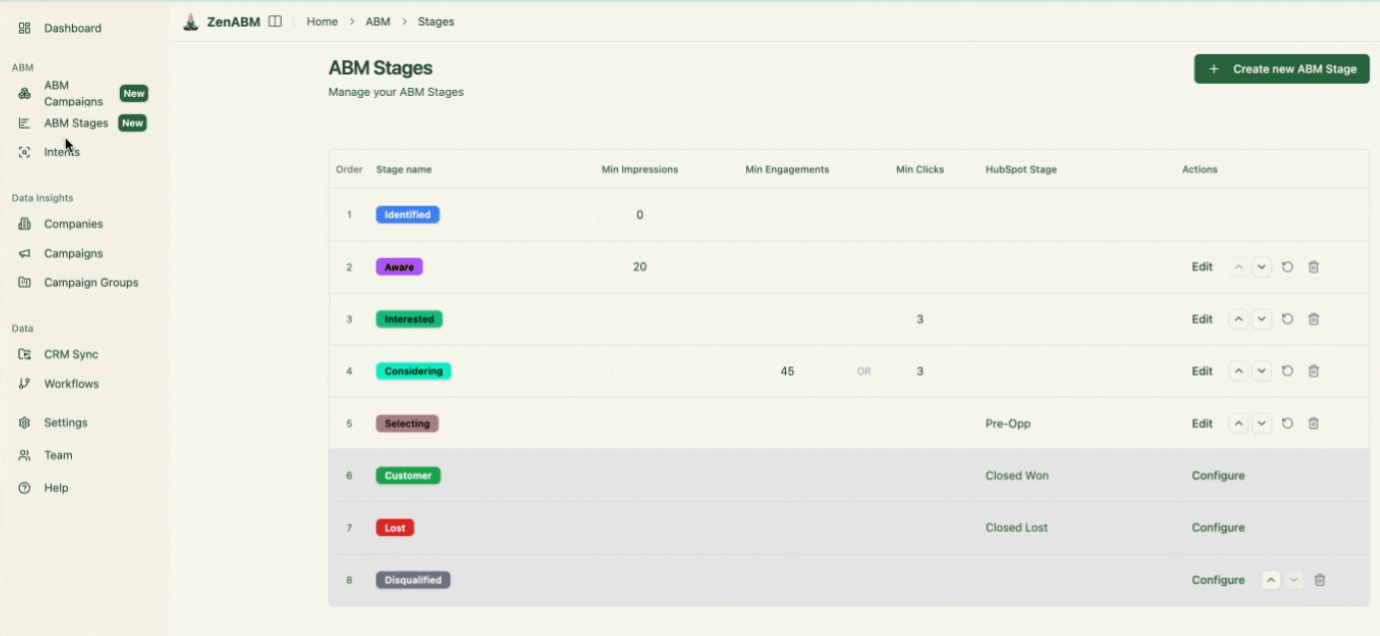

This delivers full-funnel visibility like enterprise ABM platforms, highlighting where accounts stall and where progress accelerates.
CRM Integration and Workflows
ZenABM integrates bidirectionally with CRMs such as HubSpot (Salesforce available on higher plans).
LinkedIn engagement data feeds directly into your CRM as company-level properties, keeping sales teams informed:
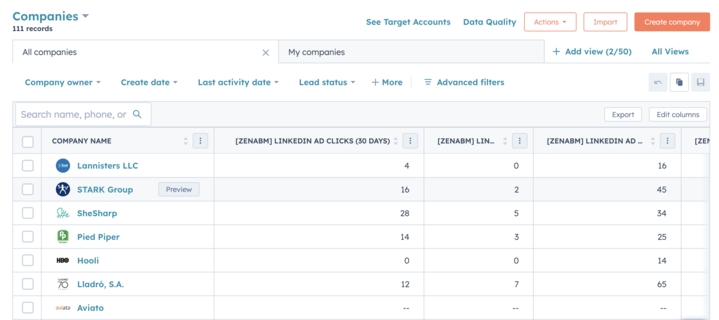
ZenABM can auto-update account stages to “Interested” when engagement passes a set threshold and assign accounts to specific BDRs for follow-up.

Intent Tagging from LinkedIn Ads Engagement
ZenABM allows you to tag campaigns by theme (like “Feature A” vs. “Feature B”) and shows which accounts engage with which themes, revealing their priorities.
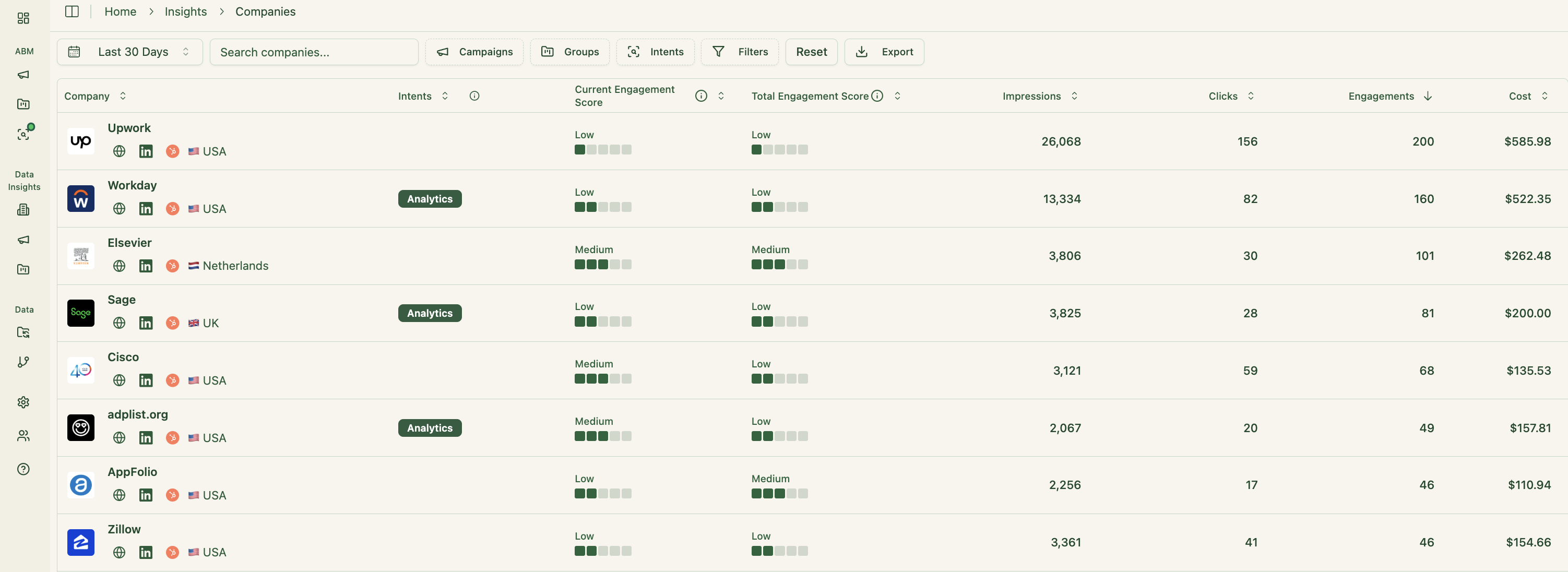
This is genuine first-party intent. Instead of paying for inferred keyword interest, you get direct proof like Account Z clicking “Feature A” ads, demonstrating actual buying interest.
These insights also sync to your CRM, supporting highly targeted outreach and relevant messaging.
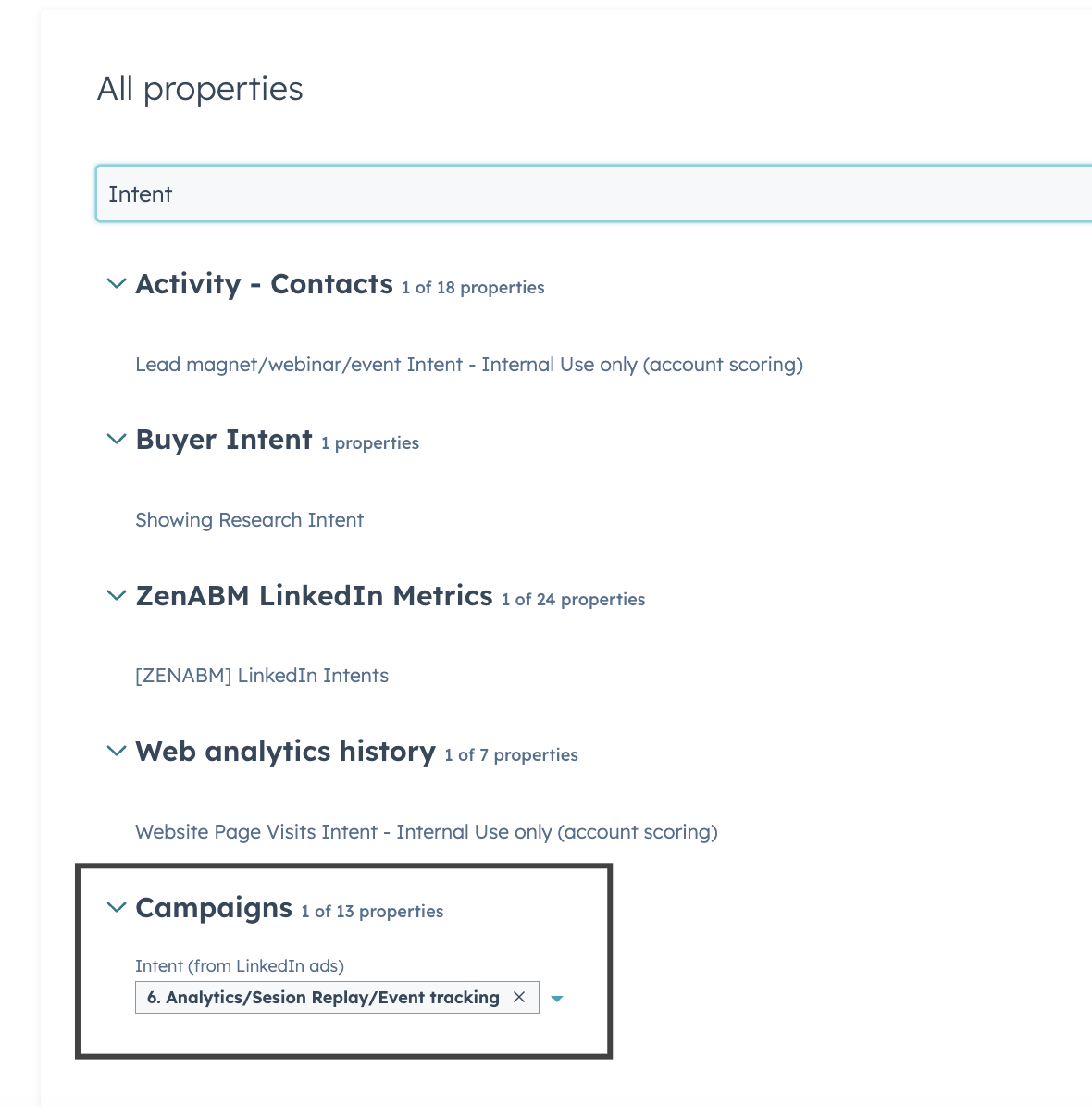
Your sales reps can instantly see which topics or pain points each account reacts to most.
This feature is fairly unique to ZenABM, making it a worthwhile add-on even if you already have an existing subscription to some other ABM tool.
Job-Title Analytics
ZenABM also gives a breakdown of the specific job titles that interact with your ads.
Raw metrics, dwell time, full video funnel – all available out of the box.
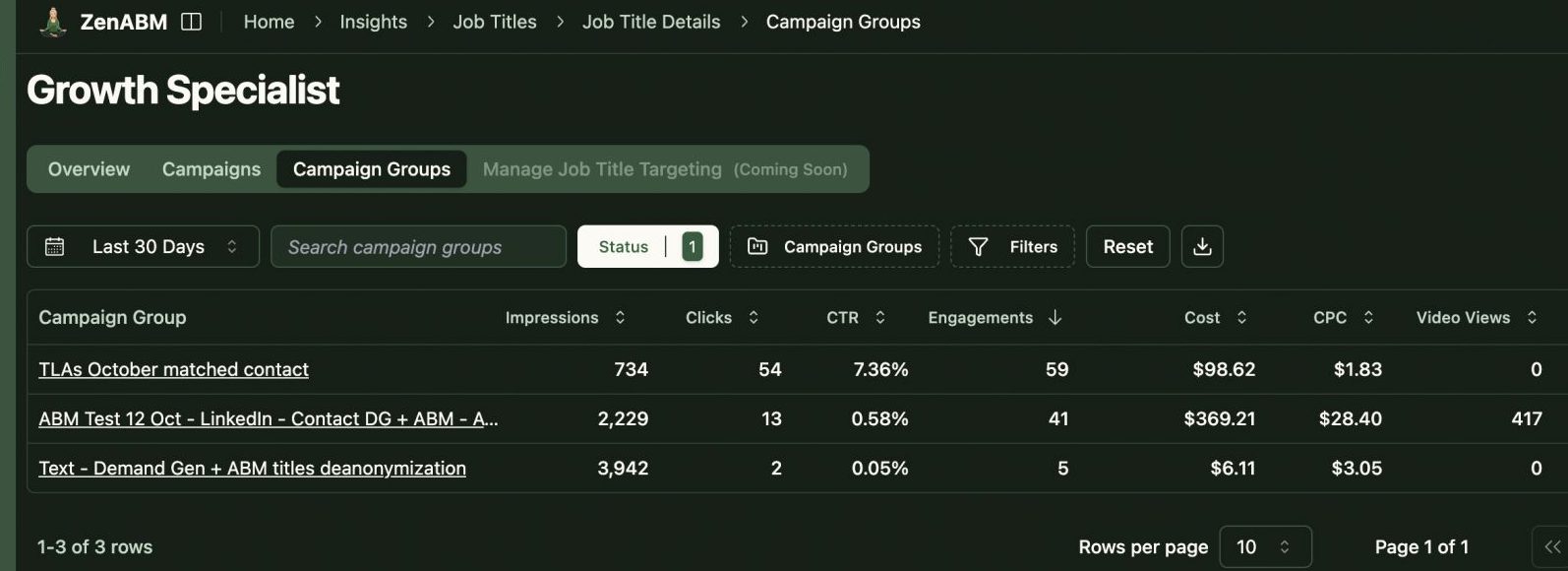
Built-in Dashboards and ABM Analytics
ZenABM includes pre-built ABM dashboards linking ad exposure, engagement, funnel stages, and pipeline metrics.
- Track performance across campaigns, LinkedIn groups, and individual ads:
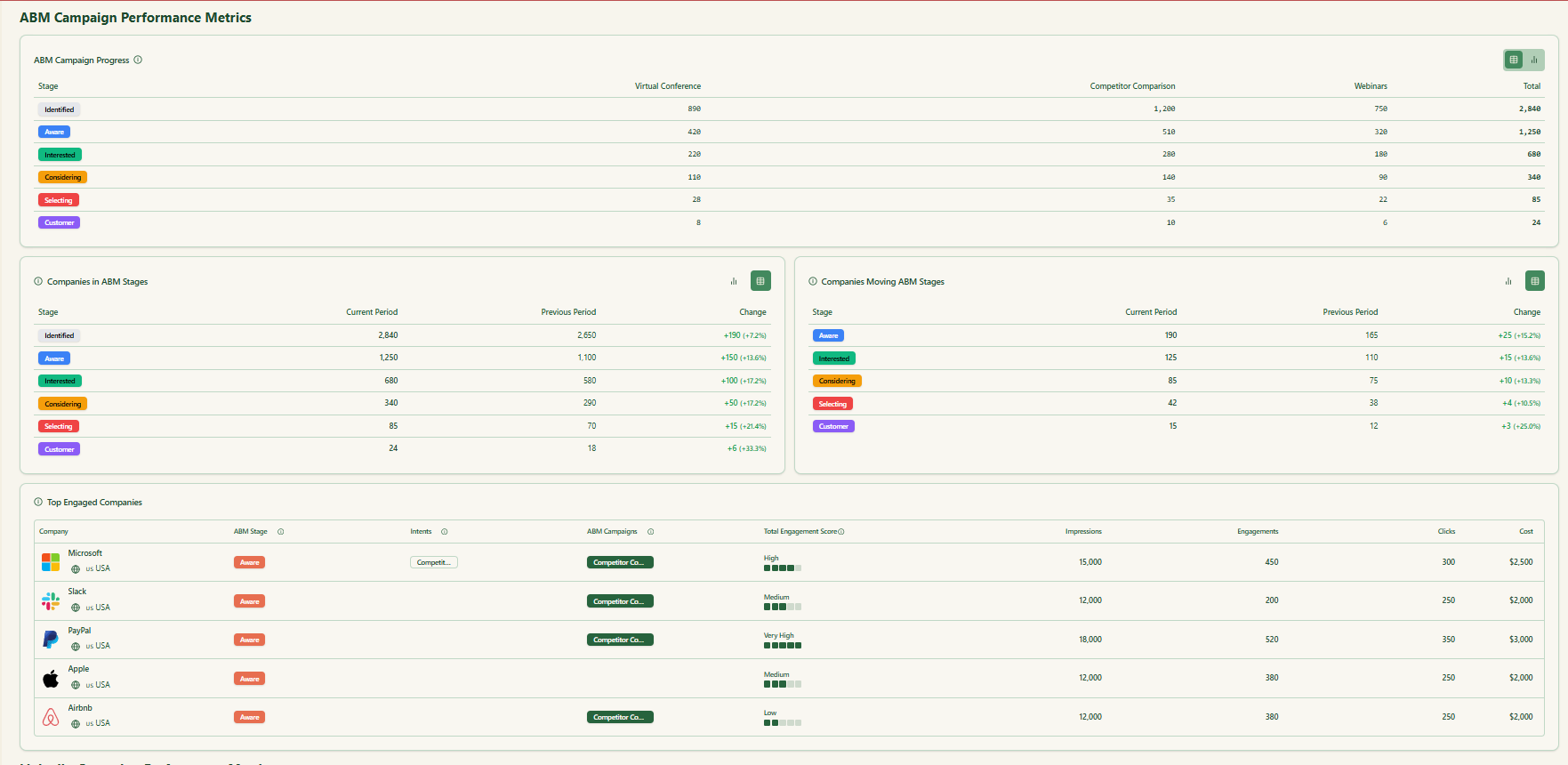

- ZenABM tracks both deal size and ad spend per account/campaign, enabling ROAS, pipeline per dollar, and campaign-driven revenue insights. Revenue teams can use this to optimize engagement and accelerate deal closure rather than focusing on vanity metrics

Custom Webhooks
With the newly rolled out custom webhooks, ZenABM can fit into any of your workflows as needed.
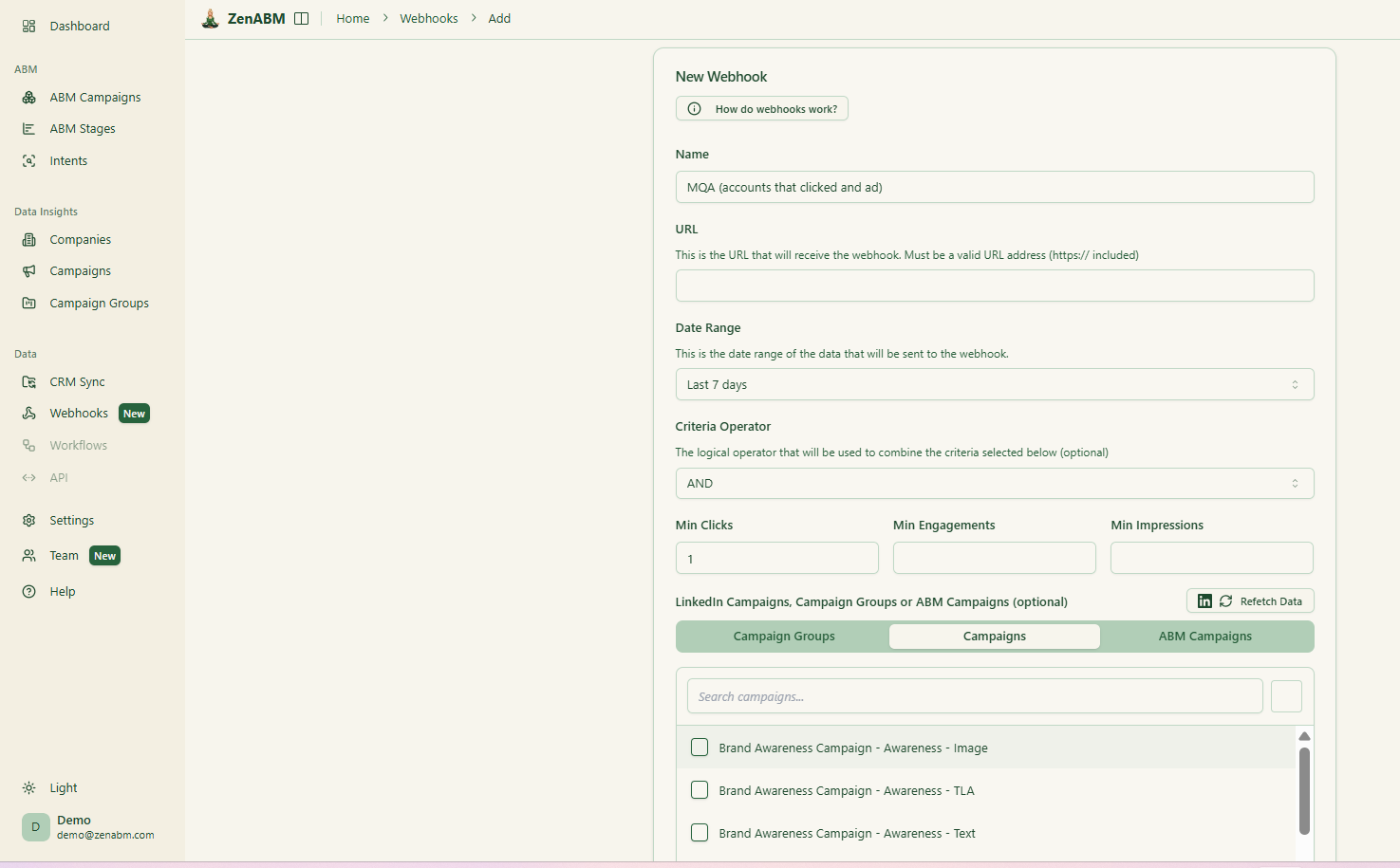
ZenABM Pricing
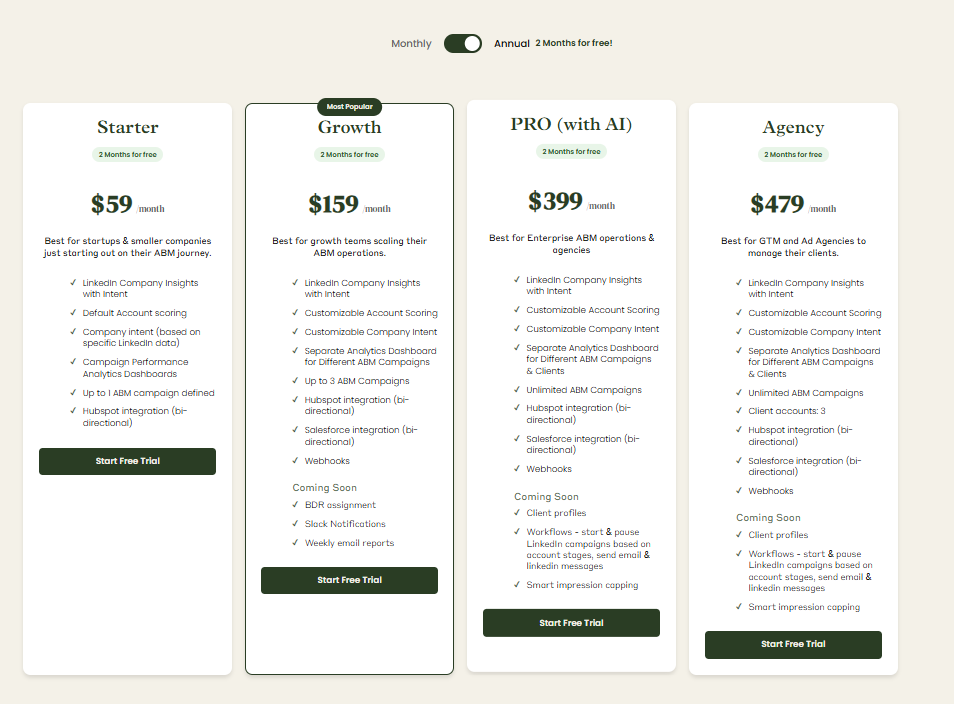
Plans start at $59/month for Starter, $159/month for Growth, $399/month for the Pro (AI) tier, and $479/month for the agency tier.
Even the highest tier costs under $6,000/year, far less than what Influ2.
All plans cover essential LinkedIn ABM functions, with higher tiers mostly expanding limits or adding Salesforce integration.
Pricing is flexible (monthly or annual with two months free), and a 37-day free trial allows teams to try before buying.
Conclusion
Influ2 brings an interesting twist to ABM with its person-based targeting, and for teams who can afford the high credit-driven pricing, it can deliver sharp visibility into individual buyer behavior.
But once you weigh the cost structure, the learning curve, and the mixed reliability of person-level signals, it becomes clear that it isn’t the universal answer for B2B marketers.
If your primary focus is LinkedIn ABM and you want first-party engagement insight, cleaner pricing, and a faster path to pipeline visibility, ZenABM is the more practical fit.
It delivers the core capabilities most teams actually need without the bulk or the surprise bills.
Whether you’re starting your ABM journey or looking to fill gaps in your current stack, it’s worth exploring ZenABM’s 37-day free trial.



